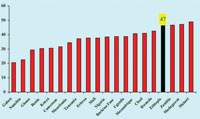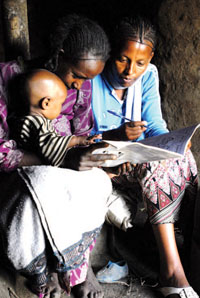13.1 Nutrition information system (NIS)
As a Health Extension Practitioner, you deliver a range of services to the community and record your activities for the purpose of reporting. These routine service records can be used to generate important data for the nutrition information system (NIS). This is a system of continuous collection, analysis and interpretation of nutrition-related data for making timely and effective decisions to improve the nutritional health of the population. Any good NIS will consist of the following features:
- The ability to detect and prevent malnutrition epidemics during times of insecurity
- The ability to collect and process information easily so that information can be available promptly to various levels of government administration and the local community for making policy decisions and developing intervention programmes
- As far as possible, it uses data and information already available from the routine service returns at the local level
- It is designed so that the information can be collected and processed by frontline health workers (such as Health Extension Practitioners) in the community
- It serves as a monitoring mechanism for higher level government administrators (regional and federal levels) so that information can be communicated to them timely way without creating additional reporting arrangements.
The NIS facilitates prompt action and should be able to show trends (situations over a period of time) in nutrition in the country. The NIS has to function as a timely warning and intervention system (TWIS) and a system for linking problem-prone areas (community, woreda, regional and federal levels), with higher authorities at woreda and federal levels. It should also provide indicators that can serve as early detection mechanisms together with data of food crises from other sectors. Finally, an effective NIS should guide prompt action to cope with deterioration of the nutritional status of vulnerable people in the population, particularly among poor households, as well as children and mothers.
Generating relevant data is an important part of your role and helps to signal possible food shortages or the determination of the nutrition status of people in your community.
The NIS is aimed primarily at using data generated by the different programmes to help the decision-making process for mobilising resources in a targeted and appropriate way. As a frontline health worker, you can make use of the data generated by the system, together with other early warning signs diagnosed by the agricultural and other relevant sectors on food shortages or problems, in order to hasten timely interventions at all levels. The data you generate in your work (for example, the weight of infants in your community) is part of the overall information system and therefore has vital importance in helping to address nutrition problems and protect the people you work with in your community.
As a Health Extension Practitioner, you’re the one at the community level to have first-hand information indicating people's wellbeing. If you use data effectively you can communicate information about a problem as fast as possible to the next level above you which in turn can forward crucial information to the highest decision-making level. Authorities at the Federal Ministry of Health use the information to monitor nutrition problems both at local and national levels. You should pass data onto the level above your Health Post as quickly as possible to enable effective decision making. Information is power, and having the right kind of information available at the right time enables the authorities to make effective decisions about how to address the nutritional needs of communities.
Data on different forms of malnutrition is essential to track the trends and variation of the nutritional status of a vulnerable population over time. It helps in assessment of the impact of the community-based nutrition interventions and progress towards achievement of the Millennium Development Goals. Data can be presented in different ways and draw attention to key messages. For example, look at Figure 13.1, which shows you the prevalence of chronic malnutrition (stunting) in African countries. You can see from the data that the prevalence in Ethiopia is among the highest.

Pause for a moment and think about your experience of using data generated by the routine services you are running. How have you used the data that you are generating, for example from therapeutic feeding programmes or child health days?
Other data you have to collect is on the coverage of essential community based nutrition services such as de-worming, vitamin A supplementation, and iodised salt coverage. This can be collected during nutrition interaction programmes or when you visit households (see Figure 13.2). The accuracy and reliability of all the data that is generated at the Health Post level is crucial.

Learning Outcomes for Study Session 13
